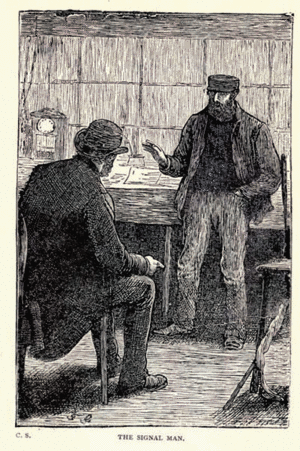The Signal-Man: Difference between revisions
imported>Russell Potter No edit summary |
imported>Russell Potter (adding info on illustration) |
||
| Line 1: | Line 1: | ||
[[Image:signalman.gif|thumb|right|300px|Illustration of a scene "The Signal-Man" by Clarkson Stanfield]] | [[Image:signalman.gif|thumb|right|300px|Illustration of a scene Dickens's "The Signal-Man" drawn by Clarkson Stanfield]] | ||
'''The Signal-Man''' is a ghost story by [[Charles Dickens]], first published in the 1866 Christmas edition of ''[[All the Year Round]]''. It was frequently reprinted thereafter, most commonly in a bound volume of Christmas Stories and "Reprinted Pieces." | '''The Signal-Man''' is a ghost story by [[Charles Dickens]], first published in the 1866 Christmas edition of ''[[All the Year Round]]''. It was frequently reprinted thereafter, most commonly in a bound volume of Christmas Stories and "Reprinted Pieces." | ||
Revision as of 14:00, 10 April 2007
The Signal-Man is a ghost story by Charles Dickens, first published in the 1866 Christmas edition of All the Year Round. It was frequently reprinted thereafter, most commonly in a bound volume of Christmas Stories and "Reprinted Pieces."
The 'signal-man' of the title tells the narrator of a ghost that has been haunting him. Each spectral appearance precedes, and is a harbinger of, a tragic event on the railway on which the signalman works. The signalman's job is to sit in a cabin near a tunnel on a lonely stretch of the line and control the movements of passing trains. When there is danger, his fellow signalmen alert him via telegraph and alarms. Three times, he receives phantom warnings of danger when his bell rings in a fashion that only he can hear. Each warning is followed by the appearance of the phantom, and then by a terrible accident. The first accident involves an awful collision between two trains in the tunnel. (It is likely that Dickens based this incident on the Clayton Tunnel crash that occurred in 1861, five years before he wrote the story. Readers in 1866 would have been familiar with this incident.) The second warning involves the mysterious death of a young woman on a passing train. The final warning is a premonition of the signalman's own death.
In 1976, the story was made into a television movie for the BBC, directed by Lawrence Gordon Clark, with Denholm Elliott in the title role, and Bernard Lloyd as the "traveller" who visits him in his lonely cabin. It was filmed on the Severn Valley Railway, and used Kidderminster Tunnel and its approach-signal box.
